Kneading bread dough is one of those things that is best taught in person. Unfortunately, most of you don’t live near me, and so I can’t offer a one-on-one kneading session!
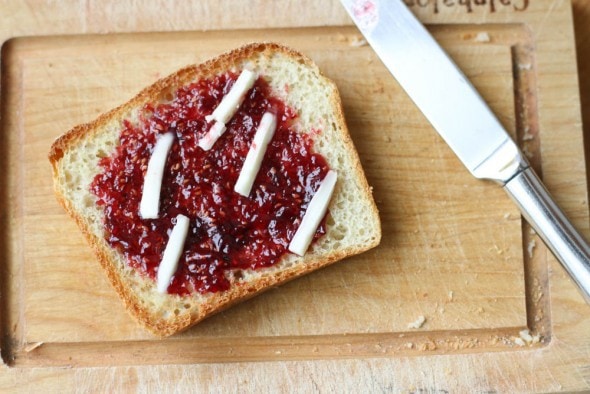
(If you do know someone who bakes, I’d highly recommend hitting up her/him for a kneading lesson).
If I were more technologically advanced, I’d upload a video, because I think that would be more helpful, but pictures are going to have to suffice for now. Props to my husband for taking these (I couldn’t do it myself, even with a tripod and timer, because my fingers were too floury!)
Proper bread kneading stretches the proteins in the flour (called gluten). The stretchy dough holds the air bubbles the yeast makes as it ferments, and this causes the dough to rise. If the gluten is not properly developed, the dough will not be strong enough to hold the air bubbles, and the bread will not rise properly.
Probably the most common mistake people make when kneading bread dough is that of adding too much flour. If the dough is too stiff and heavy, the air bubbles will not be able to lift it.
So, you want to have a stretchy, somewhat soft dough when you’re done kneading.
However, you also don’t want to have the dough sticking to the counter. Thus, it’s best to only sprinkle flour on your kneading surface, and not on the dough itself.
The idea is to keep a floured, dry surface on your dough and to keep the inside moist.
Before you turn your dough out on to the counter to knead it, you’ll want to spread some flour over your kneading surface, like so.
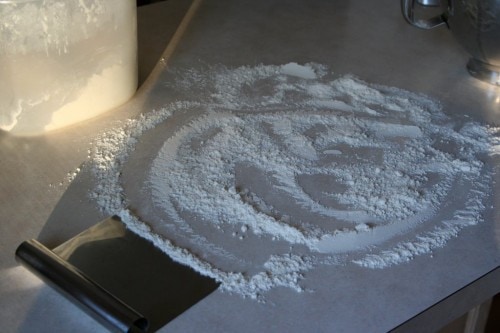
Turn your bread dough onto the floured surface. If this is your first time kneading, you might want to make your dough a little stiffer than this before you try to knead it. I’m not sure why I left it so soft on this particular day!
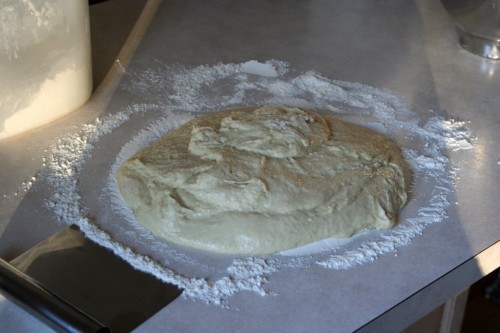
I like to use a bench knife(the stainless steel tool you see in these pictures) to help with the early stages of kneading. At first when I knead, I use the bench knife to sort of fold the outsides of the dough towards the middle.
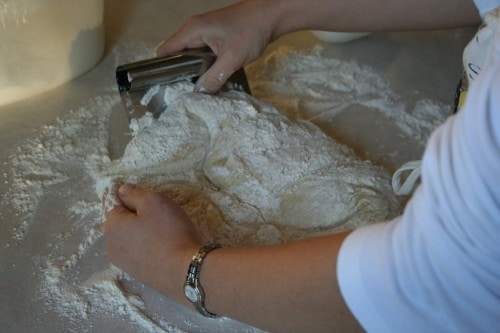
I do this, adding flour as necessary, until the dough looks like this. Then I switch to using just my floured hands. My basic kneading pattern is to fold the dough in half, push it with the heels of my hands, give it a quarter turn, and repeat the process.
Here I’m getting ready to fold it.
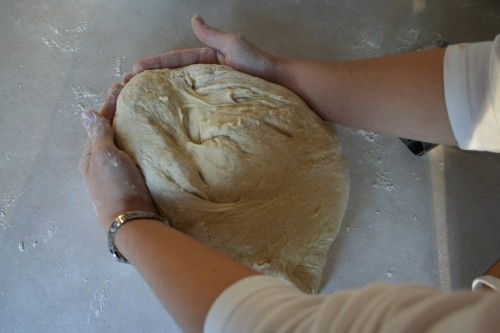
I don’t fold it all the way over, as you can see.
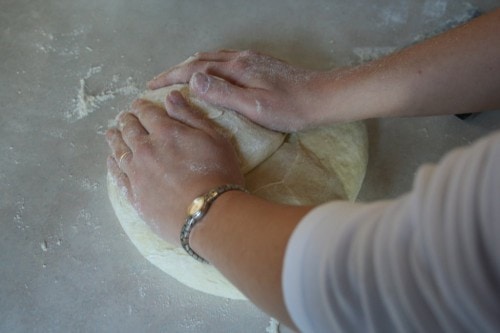
This is the push…
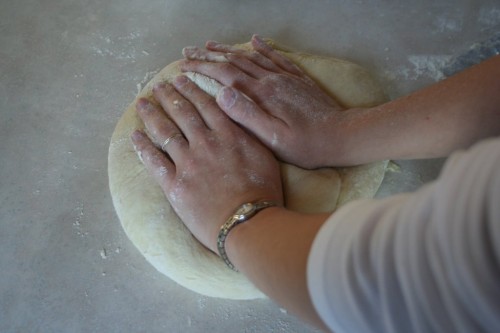
Getting ready to do the quarter turn…
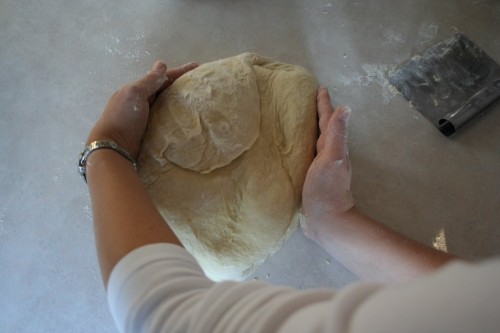
and now it’s turned.
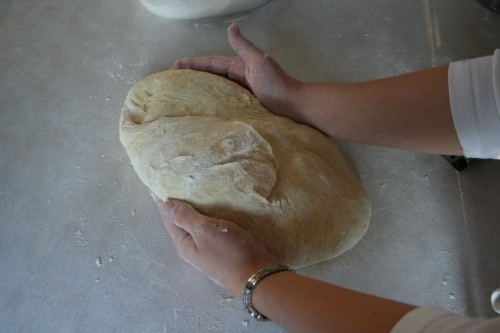
Then the process starts all over again.
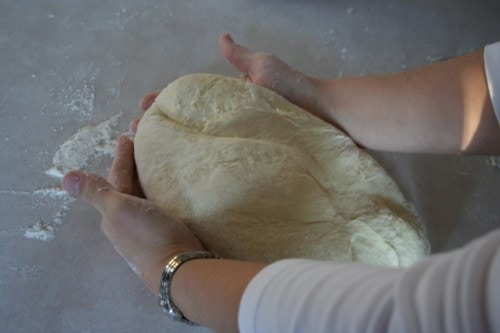
Depending on how much you mixed the dough before kneading it, this process can take anywhere from 5-10 minutes. To check if your dough is sufficiently kneaded, give it a quick poke with your finger. If it bounces back, you’re done. If it’s really slow to bounce back, or the hole doesn’t fill in at all, you need to knead some more.
Most bread doughs should look something like this when you’re done kneading.
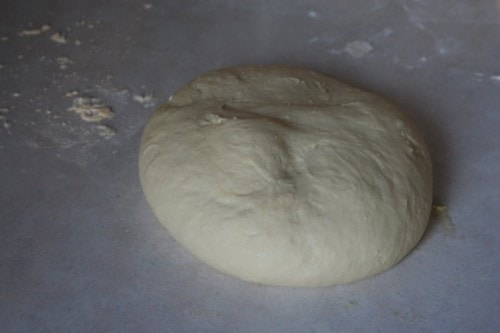
Of course, this is not the only way to knead bread…other bakers have different methods, and if you’ve found a method that works well for you, you need not feel any pressure to switch to my method. The important thing is that the dough gets pushed and stretched so that the gluten develops.
I’ll post an easy bread recipe next week so you can practice your new kneading skills.
Should you decide to try before then, though, I’d just encourage you to not give up if your first attempt at kneading is awkward and messy…it takes some practice to develop a good kneading rhythm, and you won’t get good at it if you give up too soon.
And of course, you can feel free to email me or leave a comment if you have a question or run into a problem.

Kay
Tuesday 24th of November 2020
I live in Fl. I try to follow yeast rolls recipe but always have to add a lot more flour because dough continues to be really sticky and not pull away from the sides like it s suppose to. The rolls rise but tend to be dry Should I add more liquid at the beginning knowing that I will have to use quite a bit more flour. I use a dough hook to knead
Kristen
Tuesday 24th of November 2020
Adding more liquid will probably result in you just having to add even more flour, I'd guess.
Could you make peace with it not pulling away from the sides of the bowl? Maybe just try it out and see what happens when you work with a stickier dough. You can grease your hands or oil your counter if sticking is too big of a problem.
Let me know how it goes!
jill
Tuesday 28th of January 2020
When I knead the dough I get a hole on the bottom of the dough . It seems that when I turn the side in it doesn't stick and so a hole gradually develops. If you can advise me I would appreciate it I follow a recipe with 3 cups of bread flour, 1 tsp yeast 1 tsp salt 1 1/3 cup warm water which I put the yeast in to ferment. The dough is not soft
Kristen
Tuesday 28th of January 2020
I would try using a little bit less flour to start with if the dough is not soft. Maybe it's not soft enough to stretch as you knead?
mel
Friday 31st of May 2013
This helped a lot. I did a little baking on my own in the past as my mom wasn't much of a baker, and well kinda gave it up for a few years while I was too busy, but I decided a two hour bun recipe today and am using your technique. Thank you for the insight. Feel free to send me baking tips.
Linda
Thursday 31st of January 2013
I did a loaf tonight an it was ok but it was doughy.What kids of yeast do you suggest I use .I got mine from the grocery store so no telling how long it was there.Your site has been helpful will tune in again.Thanks
Kristen
Tuesday 19th of February 2013
Usually doughy bread is a result of too much flour, and not because of failed yeast. Bread dough should be fairly soft and flexible, not stiff, as soft dough rises much better.
I used Red Star yeast, which I buy in a large package from Costco.
Marisa
Wednesday 16th of May 2012
I just came to get a little refresher on kneading - I watched your slideshow a few years ago and found it super helpful. BUT ... it seems to be missing! (Which makes sense, since I know this post is three years old.) Can you please re-post the slideshow somewhere, or have Mr. FG or Joshua help you with a video? Pretty please?